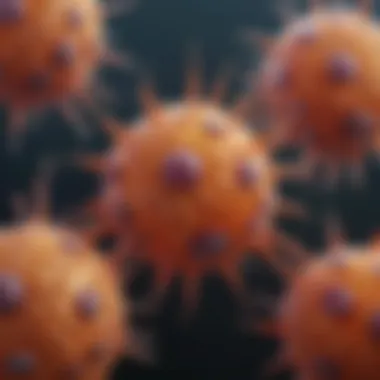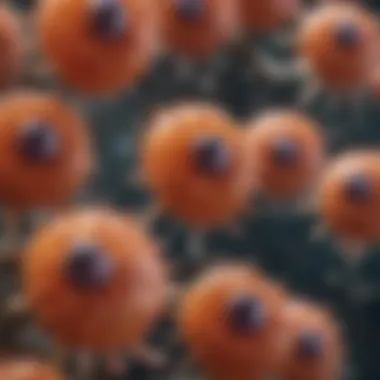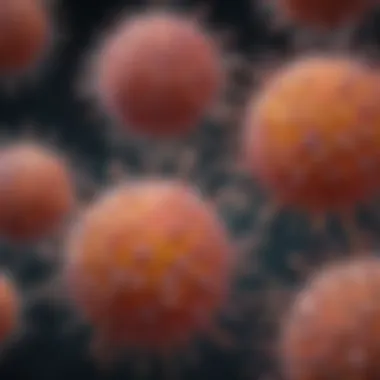Understanding MKN45 Cells: Their Biology and Uses


Intro
MKN45 cells play a critical role in understanding gastric cancer biology. This human gastric cancer cell line offers unique insights into tumorigenesis and treatment responses. The study of MKN45 cells is essential for researchers aiming to develop therapeutic strategies against gastric cancer. Their properties make them suitable for a variety of experimental approaches. Understanding this cell line is foundational for advancing cancer research and improving outcomes for patients.
Background and Context
Overview of the research topic
MKN45 cells, derived from a gastric adenocarcinoma, have emerged as an important model in oncology. They are instrumental for studying the mechanisms underlying gastric cancer progression. The distinct morphology and genetic makeup of these cells provide a valuable platform for both in vitro and in vivo studies.
Historical significance
The establishment of MKN45 cells in the early 1990s marked a turning point in gastric cancer research. This cell line allowed scientists to explore various pathways associated with tumor growth and metastasis. Over the years, many publications have cited MKN45 cells, highlighting their relevance in preclinical studies. Researchers continuously investigate their behavior in response to different treatments.
Key Findings and Discussion
Major results of the study
Research utilizing MKN45 cells has led to significant findings regarding drug resistance mechanisms and biological behavior. Studies indicate that MKN45 cells display a high level of resistance to conventional chemotherapy agents. This characteristic presents challenges in treatment responses and necessitates further investigation into alternative therapeutic options.
Detailed analysis of findings
Detailed analysis reveals that MKN45 cells exhibit mutations commonly found in gastric cancer patients, notably in genes such as TP53 and K-RAS. These mutations play critical roles in the pathways regulating cell cycle and apoptosis. Such characteristics mirror the complex nature of gastric tumors in patients. Furthermore, MKN45 has been employed in various studies to assess the efficacy of novel agents, including targeted therapies.
"MKN45 cells remain a relevant model for studying gastric cancer, shedding light on treatment resistance and molecular mechanisms."
Research has also characterized cytokine production and the impact of the tumor microenvironment on MKN45 behavior. Understanding these interactions is key to informing therapeutic strategies.
Through the continued study of MKN45 cells, researchers can pursue groundbreaking discoveries that enhance our understanding of gastric cancer and improve treatment methodologies.
Prolusion to MKN45 Cells
MKN45 cells represent a significant focal point in cancer research as they embody unique biological characteristics that mirror certain aspects of human gastric cancer. Understanding these cells is crucial for professionals engaged in oncology, as they provide insights that can lead to more effective treatment strategies and therapies. The relevance of MKN45 cells extends beyond basic research into practical applications, making them a pivotal component in the ongoing battle against cancer.
Researching MKN45 cells allows for the investigation of various biological processes. This includes, but is not limited to, cancer progression, metastasis, and response to drugs. Such studies highlight the potential of MKN45 cells as a model for designing clinical trials and evaluating drug efficacy.
Definition and Origin of MKN45 Cells
MKN45 cells are a human gastric cancer cell line derived from the gastric tumor tissues of a patient. This cell line was established in Japan in the 1980s. The nomenclature reflects not only their origin but also their specific lineage, as the MKN part indicates a relationship to the stomach, while the number denotes the specific culture line.
The initial isolation of MKN45 cells allows researchers to pursue extensive investigations into the biology of gastric cancer. The cells are known to exhibit characteristics of poorly differentiated gastric carcinoma, making them suitable for research focusing on aggressive forms of cancer.
Historical Context of MKN45 Cell Line Development
The development of the MKN45 cell line corresponds to a broader movement within cancer research during the late 20th century. As researchers sought reliable models to study various types of cancer, the establishment of the MKN45 line represented a step forward in understanding gastric cancer. The historical timelines of cancer cell lines provide critical insight into how research methodologies evolves.
In the early days, cell lines like MKN45 were crucial for developing new treatments. They facilitated in vitro studies necessary for understanding how gastric cancer cells respond to different therapies. As molecular and cellular biology advanced, the usefulness of MKN45 cells grew, contributing to our current understanding of not just gastric cancer, but also the cellular mechanisms underlying various malignancies.


Through systematic exploration of MKN45 cells, researchers have been able to highlight potential molecular targets for therapy, thus enhancing the clinical relevance of this cell line. The importance of documenting the history of MKN45 cells rests in understanding how this cell line has shaped studies in cancer biology, offering base data for future research and experiments.
Characteristics of MKN45 Cells
MKN45 cells offer significant insights into gastric cancer research due to their unique biological properties. Understanding their characteristics is essential for deploying them effectively in studies. Key aspects include their morphological traits, genetic composition, and growth behavior. By exploring these features, researchers can not only improve experimental designs but also enhance therapeutic strategies that target gastric cancer.
Morphology and Growth Conditions
MKN45 cells are notable for their distinct morphology. These cells typically present with an irregular shape and exhibit a tendency to form clusters. This morphological behavior can influence their interaction with other cells and the extracellular matrix, which is crucial in understanding tumor behavior in vivo.
In terms of growth conditions, MKN45 cells thrive in specific culture environments. They require a medium supplemented with essential nutrients. RPMI 1640 medium is often used, along with 10% fetal bovine serum. The cells also need to be maintained at 37 °C and in a 5% CO₂ atmosphere to ensure optimal growth. These controlled conditions play a pivotal role in facilitating their proliferation and sustaining their characteristics.
Considerations for culturing MKN45 cells include:
- Temperature: Optimal at 37 °C
- CO₂ Levels: Maintain at 5%
- Medium: Use RPMI 1640 supplemented with 10% fetal bovine serum.
Genetic Makeup and Molecular Profile
The genetic and molecular profile of MKN45 cells is crucial for understanding their behavior in cancer studies. MKN45 cells carry mutations characteristic of gastric cancer. Notably, they express overactive oncogenes and exhibit downregulation of tumor suppressor genes. These genetic traits are pivotal in defining their role as a model for studying gastric malignancies.
Key genes of interest in MKN45 cells include p53 and K-Ras, both known for their involvement in cell cycle regulation and signal transduction pathways related to cancer.
Major aspects of their genetic profile are:
- Presence of mutations in key oncogenes
- Downregulation of critical tumor suppressor genes
- Expression of proteins that facilitate cell proliferation.
Growth Characteristics and Doubling Time
MKN45 cells have a characteristic growth pattern that is invaluable in research contexts. Their doubling time is approximately 24 to 36 hours under optimal conditions. This ratio allows researchers to plan experiments around the availability of sufficient cell numbers while also examining the effectiveness of therapeutic interventions.
Growth characteristics include a robust response to growth factors. However, they also show varying sensitivity to treatments, providing a practical platform for drug response testing. These traits underscore the importance of MKN45 cells in elucidating mechanisms of chemotherapy resistance often observed in gastric cancer patients.
Growth traits to note are:
- Doubling time ranges from 24-36 hours
- Exhibiting sensitivity to several therapeutic agents
- Robust proliferation under ideal conditions.
MKN45 cells serve as a vital tool for understanding gastric cancer biology and testing novel therapeutic strategies.
MKN45 Cells in Cancer Research
MKN45 cells serve as a crucial tool in cancer research, particularly in studies focused on gastric cancer. These human gastric cancer cell lines provide insights into the biology of tumors, enabling researchers to make significant strides in understanding disease mechanisms. The detailed properties of MKN45 cells allow them to mimic the intricate behavior of gastric tumors, making them a sound choice for various experimental setups.
The importance of MKN45 cells is not limited to their origin and characteristics, but extends into how they contribute to therapeutic strategies. They present a model that bridges the gap between lab findings and potential clinical applications. Examining tumor responses and treatment efficacy in controlled environments using MKN45 cells offers benefits to researchers seeking effective cancer therapies.
MKN45 cells are also valuable for drug response testing. This characteristic helps scientists identify how different treatments can affect tumor proliferation and survival. By using these cells, researchers can gauge the efficacy of various drugs, thus paving the way for personalized medicine approaches. With such data, better treatment regimens can be developed based on individual profiles.
Role in Gastric Cancer Studies


Gastric cancer remains a leading cause of cancer-related deaths globally. The MKN45 cell line has been instrumental in elucidating the underlying biological mechanisms of this disease. Researchers utilize these cells to explore pathways involved in tumor initiation, progression, and metastasis. MKN45 cells are often employed to study genetic aberrations typical of gastric cancer, such as mutations in the TP53 gene and alterations in the cell cycle regulatory proteins.
Utilizing MKN45 cells aids in the investigation of the tumor microenvironment. Furthermore, studying cell interactions can quantify how gastric cancer cells respond to various stimuli. Understanding these interactions helps in identifying new therapeutic targets, potentially leading to improved treatment outcomes. The ability to conduct experiments in vitro with these cells allows for the isolation of specific variables that influence gastric cancer behavior.
MKN45 Cells and Drug Response Testing
MKN45 cells play a pivotal role in drug response testing thanks to their reproducible growth and consistent response to treatments. Researchers often employ these cells to assess the pharmacological viability of new anti-cancer agents. Studies focused on testing chemotherapeutic drugs leverage MKN45 cells for their reflective characteristics of in vivo gastric tumors.
The testing process often involves treating MKN45 cells with varying drug concentrations to determine dose-response relationships. Results from these tests contribute to understanding cytotoxicity and therapeutic index, which are critical for optimizing treatment protocols. Investigating how MKN45 cells react to specific agents helps highlight effective combinations of drugs, which could enhance treatment efficacy.
Moreover, the cellular response to therapies can inform researchers about potential resistance mechanisms. Identifying resistance allows for the exploration of alternative strategies that may negate these pathways, offering a more comprehensive approach to treatment.
In summary, MKN45 cells stand as a key model in cancer research, particularly regarding gastric cancer and drug response testing. Their unique properties and biological behaviors enhance the understanding of tumor biology and therapeutic pathways, ultimately aiming for improved patient outcomes.
Experimental Applications of MKN45 Cells
The experimental applications of MKN45 cells are critical in the realm of cancer research, particularly relating to gastric cancer. These cells facilitate in vitro studies that uncover elements of tumor biology, provide platforms for drug testing, and allow insights into various therapeutic approaches. Understanding these applications enhances the capacity for researchers to design effective experiments that contribute to knowledge and treatment strategies for cancer.
In Vitro Models for Tumor Biology
MKN45 cells serve as reliable in vitro models for exploring tumor biology. This includes investigation into cellular processes like proliferation, migration, and differentiation. The epithelial nature of MKN45 cells mimics the environment of gastric tumors, which aids in studying specific cellular responses to various stimuli.
Key aspects of using MKN45 cells in tumor biology studies include the following:
- Cell Growth and Division: These cells exhibit a defined growth pattern that researchers can manipulate to study tumor dynamics over time.
- Molecular Interactions: They allow for examination of signaling pathways involved in tumor progression and metastasis, essential for understanding gastric cancer biology.
- Genetic Studies: Researchers can introduce genetic modifications to MKN45, facilitating the study of gene function in cancer development.
The ability to observe how these cells respond to specific treatments makes them an invaluable tool in developing new strategies for cancer therapies. This knowledge is incrementally building a more comprehensive picture of gastric cancer biology.
Impact on Angiogenesis Studies
Angiogenesis, the process of new blood vessel formation, plays a crucial role in tumor growth and metastasis. MKN45 cells are pivotal in studying how this process interlinks with cancer progression.
Using MKN45 in angiogenesis studies allows researchers to:
- Assess Vascular Growth Factors: MKN45 can be utilized to study the secretion of factors that promote angiogenesis, such as Vascular Endothelial Growth Factor (VEGF).
- Evaluate Therapeutic Interventions: By applying anti-angiogenic agents in conjunction with MKN45, researchers can measure changes in capillary formation and tumor microenvironment.
- Model the Interaction Between Tumors and Endothelial Cells: These interactions are critical in understanding how tumors communicate with surrounding tissues to develop their vasculature.
Through these detailed approaches, MKN45 cells contribute substantially to angiogenesis research, illustrating mechanisms that underpin tumor progression and offering pathways for novel therapies.
"Understanding the role of angiogenesis in cancer is key to developing targeted therapies. MKN45 cells have proven effective in these studies."
Limitations of MKN45 Cells in Research
MKN45 cells are a critical resource in cancer research, but their use comes with significant limitations. Understanding these limitations is essential for researchers analyzing results obtained from this cell line. Awareness of the potential pitfalls can influence experimental design and interpretation and ultimately enhance the reliability of findings in the context of gastric cancer studies.
Potential Pitfalls in Extrapolating Results
When utilizing MKN45 cells, researchers must be cautious about extrapolating in vitro findings to in vivo scenarios. One key issue is the difference in the tumor microenvironment. MKN45 cells are cultured in an artificial environment, which lacks the complexities of a living organism. This absence can lead to results that do not accurately reflect how tumors would behave in the human body. Factors such as immune responses, blood supply, and intercellular communications are not replicated in vitro, and this discrepancy can significantly alter drug responses and cancer progression outcomes.


Moreover, the genetic profile of MKN45 cells might not encompass the full spectrum of gastric cancer variations. Genetic mutations identified in these cells may not entirely match those found in patients, limiting the applicability of findings. This limitation can lead to misguided conclusions about the effectiveness of treatments and the underlying mechanisms of cancer biology.
Variability Between Cell Lines
MKN45 is just one among various cancer cell lines used in research. Each cell line possesses distinct biological characteristics, which can lead to variability in experimental results.
For instance, different cell lines might exhibit different growth rates and responses to therapies. This variability poses a challenge when comparing results across studies that utilize different cell lines. Results obtained from MKN45 might not effectively translate to findings from other gastric cancer cell lines, such as AGS or SGC-7901.
Additionally, factors like patient origin, passage number, and culture conditions contribute to differences in cell behavior. Parameters such as medium composition, incubation time, and substrate can lead to variation between laboratories. As such, researchers should be diligent in standardizing conditions to mitigate these differences.
Future Directions for MKN45 Cell Research
Research on MKN45 cells holds significant promise for furthering our understanding of gastric cancer. As studies continue to evolve, new directions in this field can enhance our comprehension and application of potential therapies. This section will explore integrative approaches and combination therapies, highlighting their benefits and considerations with the aim of propelling gastric cancer research forward.
Integrative Approaches in Cancer Research
Integrative approaches in cancer research involve combining various methodologies to gain a comprehensive understanding of disease mechanisms. For MKN45 cells, this means incorporating genomic, proteomic, and metabolomic analyses. This multidimensional framework allows researchers to explore the complex networks that govern cancer progression. By utilizing advanced technologies, scientists can identify crucial biomarkers in MKN45 cells that may influence treatment outcomes.
Integrative research has distinct advantages:
- Enhanced Data Interpretation: Merging various types of data can yield more profound insights. Researchers can comprehend how different cellular pathways interact within the MKN45 cell line.
- Better Therapeutic Targets: Understanding the interplay of various molecular components may lead to the identification of new therapeutic targets, crucial for developing tailored treatments.
- Network Modeling: Systems biology can create computational models of MKN45 cell behavior. These models allow for the simulation of drug responses before clinical trials, minimizing unexpected results.
Ultimately, the integration of diverse research techniques can help in understanding complex interactions and improving the efficacy of gastric cancer treatments.
Exploring Combination Therapies
Combination therapies involve using multiple drugs or treatment methods to improve patient outcomes. In the context of MKN45 cells, exploring combination therapies can provide insights into more effective treatment regimens for gastric cancer.
The importance of combination therapies lies in:
- Overcoming Drug Resistance: Gastric cancer cells, such as MKN45, can develop resistance to single-agent therapies. By combining drugs with different mechanisms of action, researchers can reduce this resistance and increase treatment efficacy.
- Synergistic Effects: Some combinations may produce synergistic effects, leading to a heightened response when compared to single agents. For example, pairing chemotherapy with targeted therapies may enhance the overall treatment response in patients.
- Customized Treatment Plans: Tailoring combination therapies based on individual patient profiles allows healthcare professionals to provide more personalized care. This patient-centric approach is crucial in improving survival rates and quality of life.
Including MKN45 cells in combination therapy research not only opens new avenues but also underscores the importance of continuous exploration in the fight against gastric cancer. As the research landscape evolves, the need for robust and innovative strategies will remain paramount.
Culmination on MKN45 Cells
The study of MKN45 cells offers notable insights into gastric cancer research. As a human gastric cancer cell line, MKN45 cells demonstrate significant characteristics that make them an invaluable tool for scientific exploration. This conclusion underscores their importance in various aspects, including drug response, tumor biology, and the broader implications for cancer therapeutics.
Understanding MKN45 cells can enhance our knowledge about cancer mechanisms and facilitate the development of targeted therapies. Their unique genetic and molecular profile allows for in-depth analysis. Researchers can use these cells to model tumor behavior accurately, evaluate the efficacy of new drugs, and explore alternative treatment methods.
Summation of Current Understanding
In summary, MKN45 cells serve as a vital resource for researchers investigating gastric cancer. Their establishment derived from a patient with gastric carcinoma allows for studies that closely mimic human disease. Current research highlights include their role in elucidating pathways of carcinogenesis and evaluating therapeutic responses.
Key aspects of MKN45 cells include:
- Morphological Traits: Unique cell shapes and growth patterns observed under various conditions.
- Genetic Analysis: Identification of specific mutations and expression profiles relevant to gastric cancer.
- Response to Therapeutics: Insights into how these cells react to chemotherapeutic agents, aiding in treatment development.
"MKN45 cells bridge the gap between bench and bedside, representing a crucial step in translating laboratory findings into clinical applications."
Call for Ongoing Research
The landscape of cancer research is ever-evolving. Continuous investigation into MKN45 cells is crucial for uncovering new therapeutic strategies and achieving better patient outcomes. Ongoing research should focus on the following areas:
- Combination Therapies: Exploring how MKN45 cells respond to various drug combinations could enhance treatment efficacy.
- Translational Studies: Establishing links between cell line studies and patient-derived data can improve relevance in clinical settings.
- Novel Technologies: Incorporating advanced techniques like CRISPR gene editing for functional studies in MKN45 cells can reveal new cancer vulnerabilities.







